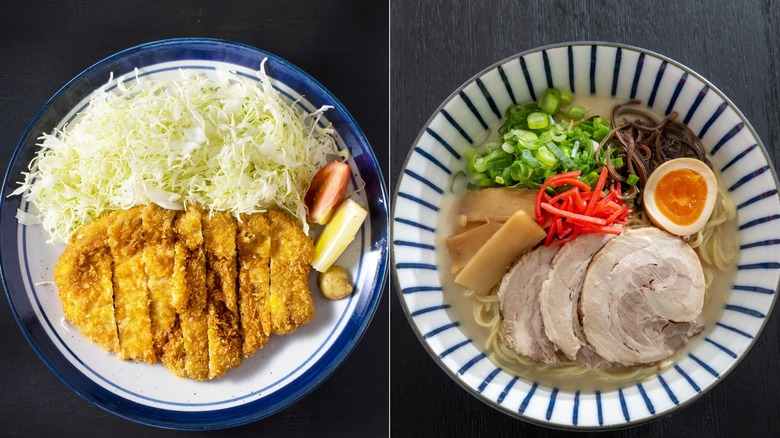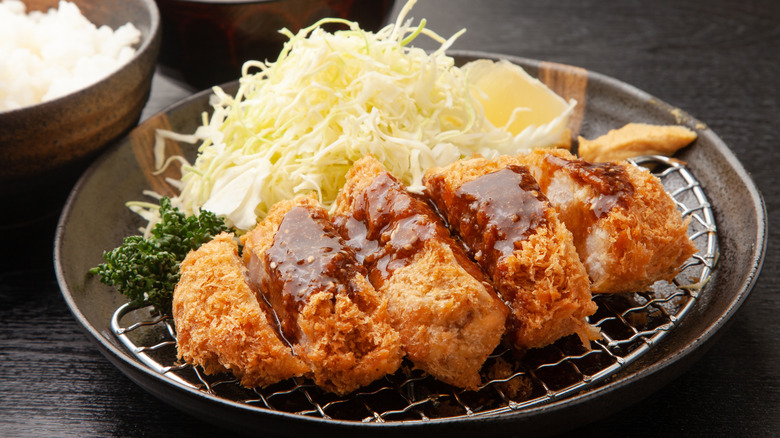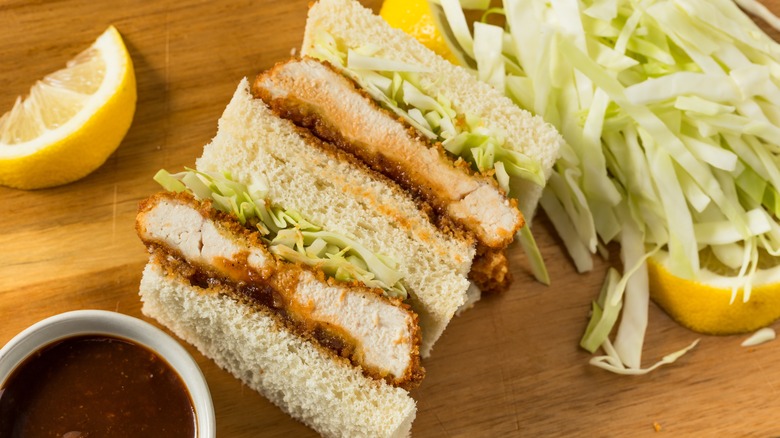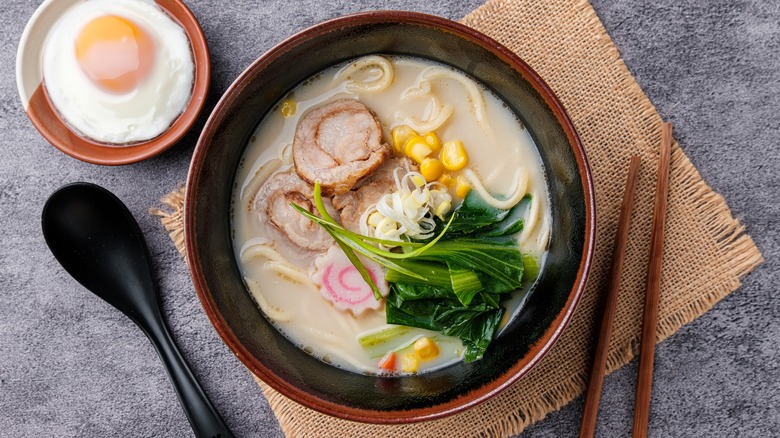Tonkatsu Vs Torikatsu Vs Tonkotsu: How To Keep The Differences Straight
Japanese restaurant menus often feature a trio of words so similar to one another that you might get confused: Tonkatsu, torikatsu, and tonkotsu. The first two are closely related, but the third is a completely different beast. The one thing all three have in common is the fact that they are delicious.
Tonkatsu and torikatsu are crispy cutlets of breaded meat, like a Japanese version of crispy Milanesa steak and chicken. In fact, the word "katsu" (spelled カツ in Japanese) is an abbreviation of "katsuretsu" (カツレツ), which is actually a Japanese transliteration of the English word "cutlet". You may recognize it from the popular katsu sando, a common sight on foodie social media.
Tonkotsu creates the most confusion because it is just one letter off from tonkatsu, but the difference is huge. Tonkotsu has nothing to do with cutlets, and is actually a type of broth used for ramen. If you go to any of America's best ramen restaurants, you will surely see tonkotsu on the menu. But even though tonkotsu and tonkatsu are completely different foods, they do have one thing in common. It's time to talk about the word "ton".
Tonkatsu is crispy pork
"Ton" (とん) is the Japanese word for pork, and much like katsu, it too has roots in another language. It is a Sino-Japanese term, which means that "tonkatsu" is a mashup of Japanese, Chinese, and English all in one. Since you already know what katsu means, you've probably figured out that tonkatsu equals "pork cutlet," but it's not just any pork cutlet. It only counts as tonkatsu if it's prepared a certain way.
The difference between tonkatsu and other crispy pork dishes like Milanesa or Wienerschnitzel comes down to the difference between panko and plain bread crumbs. Tonkatsu must always be made with panko bread crumbs. Since the turn of the 21st century, panko has become increasingly popular outside of Japan, and a lot of chefs are now preparing European-style crispy cutlets with panko breadcrumbs, which makes them very close to tonkatsu. However, there's one other thing that sets the Japanese version apart.
Tonkatsu is served with a unique sauce, also called tonkatsu, or simply katsu sauce. It combines traditional Japanese ingredients like soy sauce and mirin with Western ingredients like ketchup and Worcestershire. The final result is similar to a steak sauce, but sweeter, with a rich umami base. You can make it yourself or buy a bottle of it from a Japanese grocery store. The most popular brand is Bull-Dog. You'll see it drizzled over crispy cutlets and in katsu sandos.
Torikatsu is tonkatsu's chicken cousin
"Tori" (とり) is the Japanese word for "bird," and while it can encompass any avian species, in the context of torikatsu, it specifically refers to chicken. Torikatsu is the chicken version of tonkatsu, made with thin pieces of breast meat. Of the three terms covered here, torikatsu is the one you're least likely to encounter because Japanese restaurants in the U.S. typically list this dish on menus as "chicken katsu". The only difference between chicken katsu and tonkatsu is the choice of protein. Both dishes use panko breadcrumbs and a generous drizzle of tonkatsu sauce on top, and chicken can also be used in katsu sandos.
Chicken is the second most popular meat for making katsu, with pork being more prevalent. Interestingly, neither of these meats was used for the original version of the dish, which was first made with beef. Katsu was inspired by the French dish côtelette de veau, which is a fried veal cutlet, and adapted by Japanese chefs in the late 1800s who eventually switched to pork and then chicken as cheaper options. You can still find beef katsu in some parts of Japan, but it is far less common than tonkatsu and torikatsu, both of which are very common on Japanese restaurant menus around the world.
Tonkotsu has nothing to do with tonkatsu
Tonkotsu is a type of ramen made with pork broth. The name translates to "pig bone," which is the primary ingredient. Tonkotsu broth has a unique appearance and texture. It is almost completely opaque, so that you can barely see the noodles beneath the cream-colored surface of the soup. The texture is thick and creamy, a completely different mouthfeel than other ramen styles like shoyu and shio. This is because the bones are simmered for much longer than other types of broth, to the point that the fat, marrow, and connective tissues melt into the liquid. Tonkotsu is sometimes cooked for multiple days on end, although modern pressure cookers can cut the time down to a few hours.
Tonkotsu is newer to Japanese cuisine than katsu. The first version was made in 1937 by Tokio Miyamoto, a chef from Fukuoka prefecture in southern Japan. His version was different from the tonkotsu we know today. It was cooked for less time and the broth was more translucent. However, on a fateful day in 1947, another Fukuoka chef named Katsumi Sugino was trying to imitate Miyamoto's broth and accidentally overcooked it. He found the result was even more flavorful, and it is now one of the most popular styles of ramen in Japan and around the globe. Top a bowl of tonkotsu with a piece of braised pork belly and a soy-marinated egg, and you'll be in ramen heaven.



